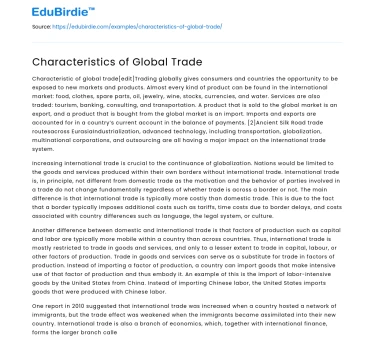Characteristic of global trade[edit]Trading globally gives consumers and countries the opportunity to be exposed to new markets and products. Almost every kind of product can be found in the international market: food, clothes, spare parts, oil, jewelry, wine, stocks, currencies, and water. Services are also traded: tourism, banking, consulting, and transportation. A product that is sold to the global market is an export, and a product that is bought from the global market is an import. Imports and exports are accounted for in a country’s current account in the balance of payments. [2]Ancient Silk Road trade routesacross EurasiaIndustrialization, advanced technology, including transportation, globalization, multinational corporations, and outsourcing are all having a major impact on the international trade system.
Increasing international trade is crucial to the continuance of globalization. Nations would be limited to the goods and services produced within their own borders without international trade. International trade is, in principle, not different from domestic trade as the motivation and the behavior of parties involved in a trade do not change fundamentally regardless of whether trade is across a border or not. The main difference is that international trade is typically more costly than domestic trade. This is due to the fact that a border typically imposes additional costs such as tariffs, time costs due to border delays, and costs associated with country differences such as language, the legal system, or culture.
Save your time!
We can take care of your essay
- Proper editing and formatting
- Free revision, title page, and bibliography
- Flexible prices and money-back guarantee
Another difference between domestic and international trade is that factors of production such as capital and labor are typically more mobile within a country than across countries. Thus, international trade is mostly restricted to trade in goods and services, and only to a lesser extent to trade in capital, labour, or other factors of production. Trade in goods and services can serve as a substitute for trade in factors of production. Instead of importing a factor of production, a country can import goods that make intensive use of that factor of production and thus embody it. An example of this is the import of labor-intensive goods by the United States from China. Instead of importing Chinese labor, the United States imports goods that were produced with Chinese labor.
One report in 2010 suggested that international trade was increased when a country hosted a network of immigrants, but the trade effect was weakened when the immigrants became assimilated into their new country. International trade is also a branch of economics, which, together with international finance, forms the larger branch called international economics.






 Stuck on your essay?
Stuck on your essay?

